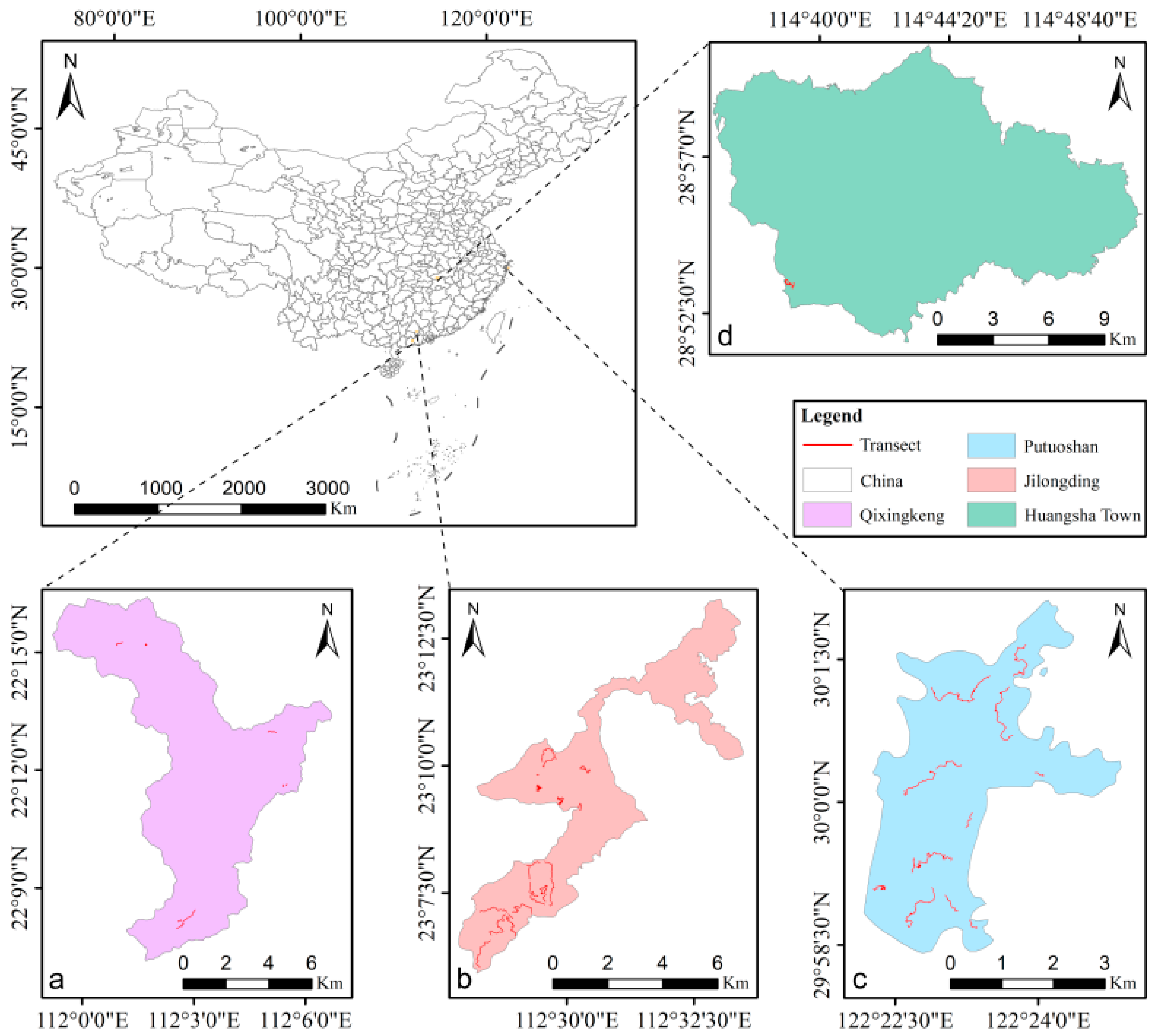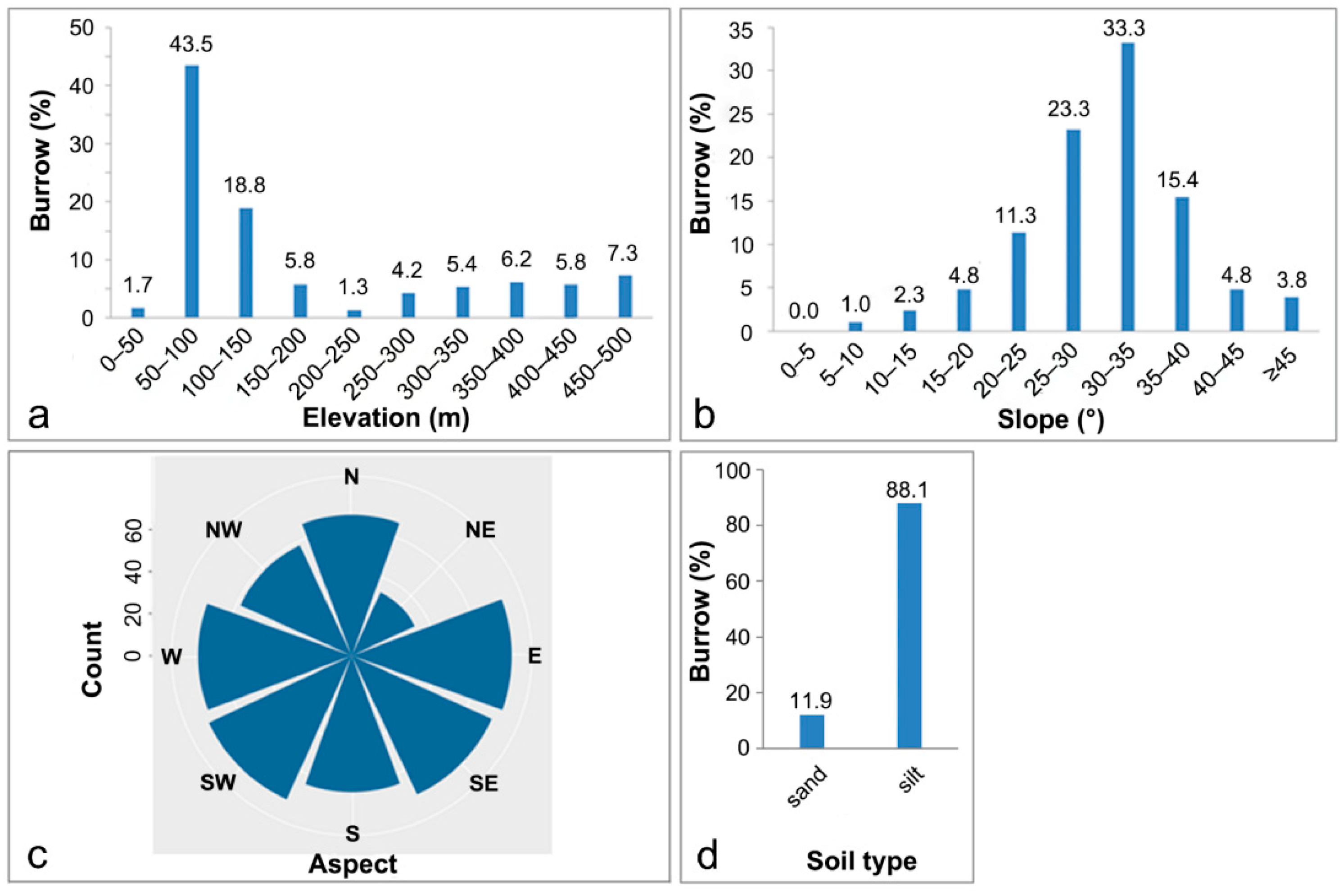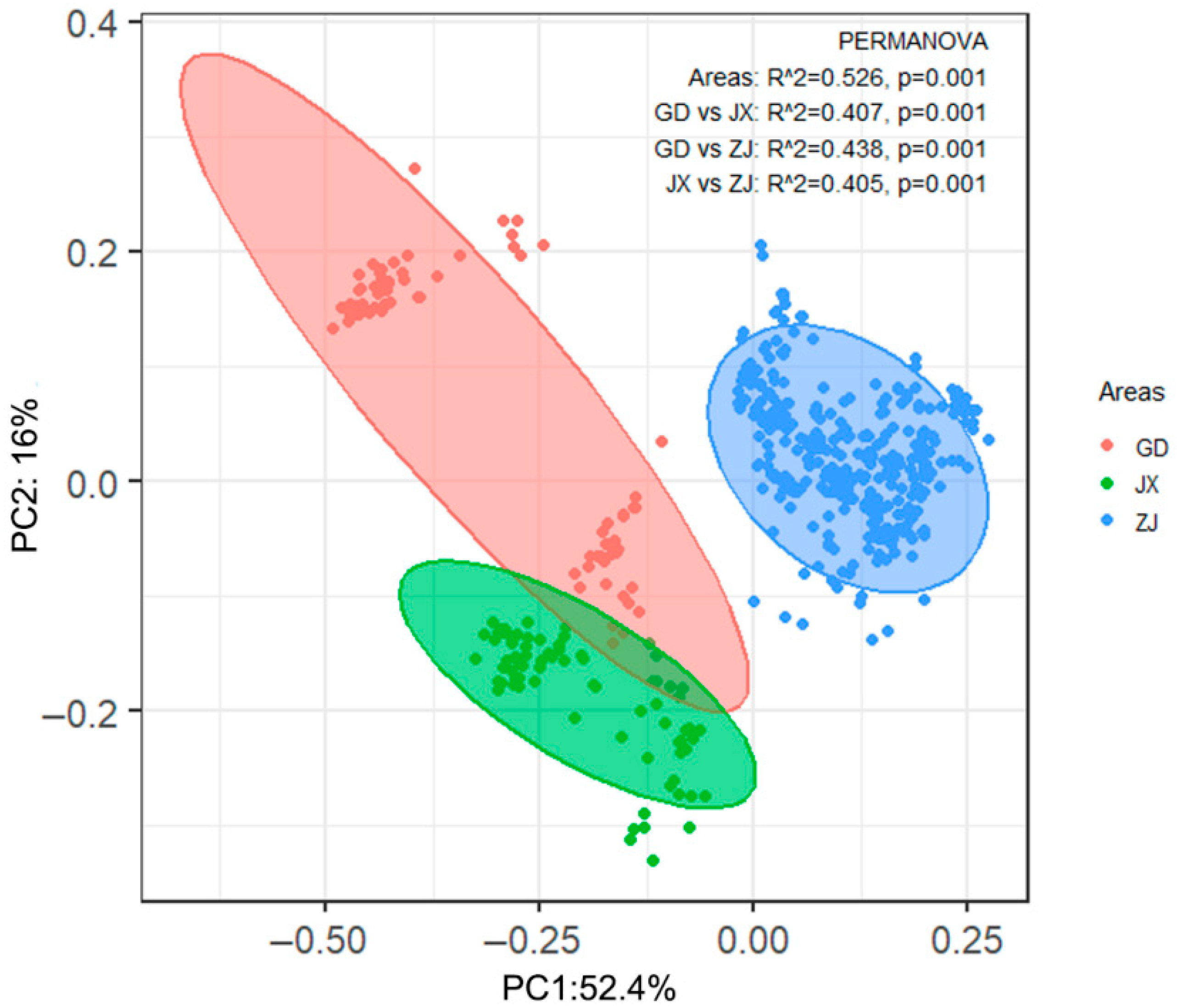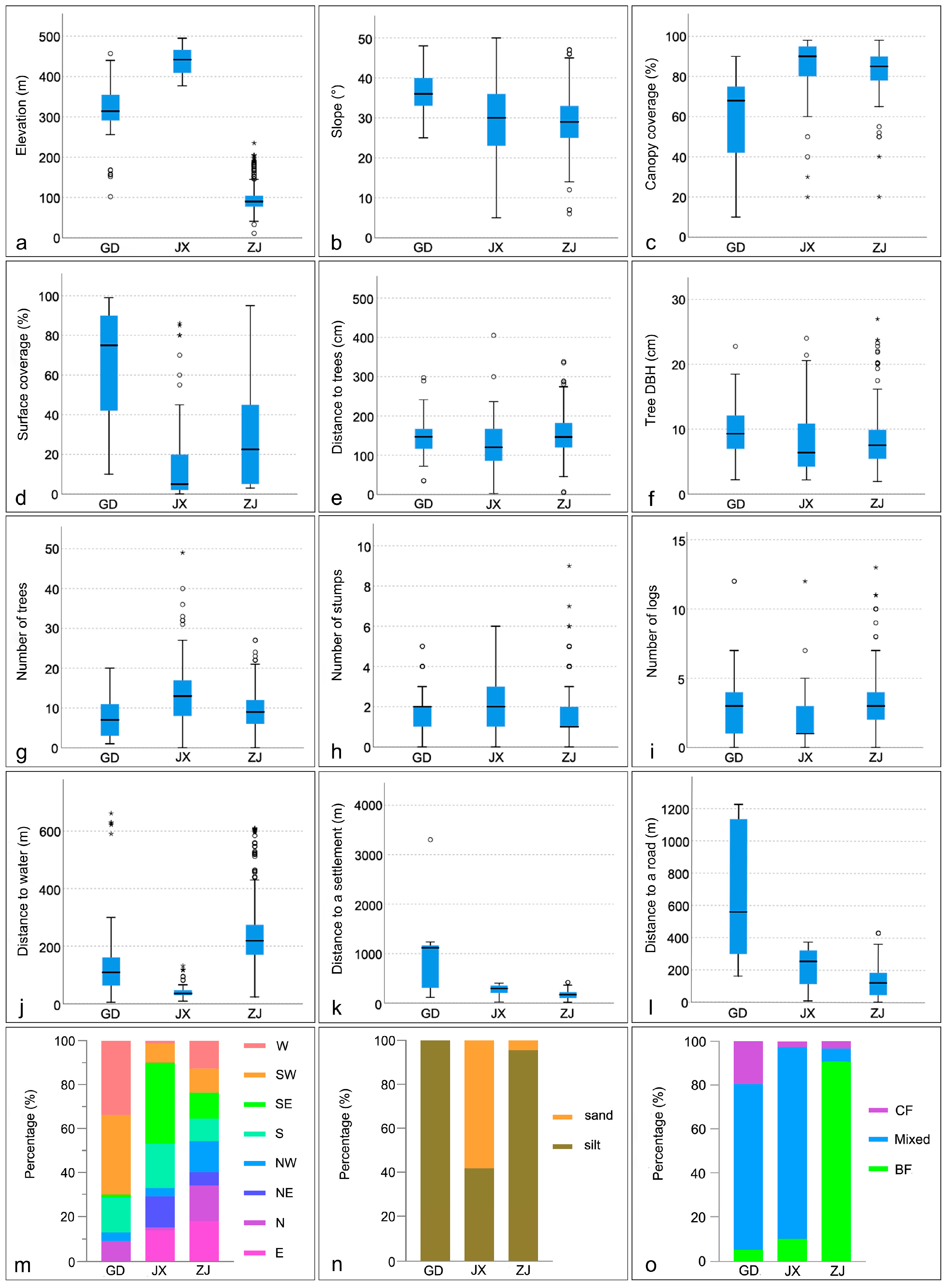Chinese Pangolins in China Demonstrate Regional Differences in Burrow Habitat Selection
Simple Summary
Abstract
1. Introduction
2. Materials and Methods
2.1. Study Area
2.2. Pangolin Distribution and Habitat Factors
2.3. Data Analysis
3. Results
3.1. Distribution
3.2. Habitat Characteristics
3.3. Key Ecological Factors Affecting Habitat Selection and Distribution
3.4. Habitat Differences Among the Study Regions
4. Discussion
5. Conclusions
Supplementary Materials
Author Contributions
Funding
Institutional Review Board Statement
Informed Consent Statement
Data Availability Statement
Acknowledgments
Conflicts of Interest
References
- Morris, D.W. Toward an ecological synthesis: A case for habitat selection. Oecologia 2003, 136, 1–13. [Google Scholar] [CrossRef] [PubMed]
- Shafer, A.B.; Nielsen, S.E.; Northrup, J.M.; Stenhouse, G.B. Linking genotype, ecotype, and phenotype in an intensively managed large carnivore. Evol. Appl. 2014, 7, 301–312. [Google Scholar] [CrossRef] [PubMed]
- Guisan, A.; Tingley, R.; Baumgartner, J.B.; Naujokaitis-Lewis, I.; Sutcliffe, P.R.; Tulloch, A.I.T.; Regan, T.J.; Brotons, L.; McDonald-Madden, E.; Mantyka-Pringle, C.; et al. Predicting species distributions for conservation decisions. Ecol. Lett. 2013, 16, 1424–1435. [Google Scholar] [CrossRef] [PubMed]
- Northrup, J.M.; Vander Wal, E.; Bonar, M.; Fieberg, J.; Laforge, M.P.; Leclerc, M.; Prokopenko, C.M.; Gerber, B.D. Conceptual and methodological advances in habitat-selection modeling: Guidelines for ecology and evolution. Ecol. Appl. 2022, 32, e02470. [Google Scholar] [CrossRef]
- Ulrey, E.E.; Wightman, P.H.; Bakner, N.W.; Buckley, B.R.; Fyffe, N.; Oleson, B.; Smallwood, A.; Heffelfinger, J.R.; Chamberlain, M.J.; Collier, B.A. Habitat selection of Gould’s wild turkeys in southeastern Arizona. Sci. Rep. 2023, 13, 18639. [Google Scholar] [CrossRef]
- Zeigler, S.L.; Gutierrez, B.T.; Hecht, A.; Plant, N.G.; Sturdivant, E.J. Piping plovers demonstrate regional differences in nesting habitat selection patterns along the U.S. Atlantic coast. Ecosphere 2021, 12, e03418. [Google Scholar] [CrossRef]
- Zhang, F.; Wu, S.; Cen, P. The past, present and future of the pangolin in Mainland China. Glob. Ecol. Conserv. 2022, 33, e01995. [Google Scholar] [CrossRef]
- Newton, P.; Nguyen, V.T.; Roberton, S.; Bell, D. Pangolins in peril: Using local hunters’ knowledge to conserve elusive species in Vietnam. Endanger. Species Res. 2008, 6, 41–53. [Google Scholar] [CrossRef]
- Duckworth, J.W.; Salter, R.E.; Khounboline, K. Wildlife in Lao PDR: 1999 Status Report; IUCN; Wildlife Conservation Society and Centre for Protected Areas and Watershed Management: Vientiane, Laos, 1999. [Google Scholar]
- Naing, H.; Fuller, T.K.; Sievert, P.R.; Randhir, T.O.; Po, S.H.T.; Maung, M.; Lynam, J.Y.; Htun, S.; Thaw, W.N.; Myint, T. Assessing large mammal and bird richness from camera-trap records in the Hukaung Valley of Northern Myanmar. Raffles Bull. Zool. 2015, 63, 376–388. [Google Scholar]
- Allen, G.M.; Coolidge, H.J. Mammal collections of the Asiatic Primate Expeditions. Bull. Mus. Comp. Zool. Harv. 1940, 97, 131–166. [Google Scholar]
- Trageser, S.J.; Ghose, A.; Faisal, M.; Mro, P.; Mro, P.; Rahman, S.C. Pangolin distribution and conservation status in Bangladesh. PLoS ONE 2017, 12, e0175450. [Google Scholar] [CrossRef] [PubMed]
- Muarya, K.K.; Shafi, S.; Gupta, M. Chinese Pangolin: Sighting of Chinese pangolin (Manis pentadactyla) in Valmiki Tiger Reserve, Bihar, India. Small Mammal Mail 416 Zoo’s Print 2018, 33, 15–18. [Google Scholar]
- Dorji, D.; Jambay; Chong, J.L.; Dorji, T. Habitat preference and current distribution of Chinese Pangolin (Manis pentadactyla L. 1758) in Dorokha Dungkhag, Samtse, southern Bhutan. J. Threat. Taxa 2020, 12, 16424–16433. [Google Scholar] [CrossRef]
- Suwal, T.L.; Thapa, A.; Gurung, S.; Aryal, P.C.; Basnet, H.; Basnet, K.; Shah, K.B.; Thapa, S.; Koirala, S.; Dahal, S.; et al. Predicting the potential distribution and habitat variables associated with pangolins in Nepal. Glob. Ecol. Conserv. 2020, 23, e01049. [Google Scholar] [CrossRef]
- Challender, D.; Wu, S.; Kaspal, P.; Khatiwada, A.; Ghose, A.; Sun, N.C.M.; Mohapatra, R.K.; Suwal, T.L. Manis Pentadactyla (Errata Version Published in 2020). The IUCN Red List of Threatened Species 2019: E.T12764A168392151. 2019. Available online: https://doi.org/10.2305/IUCN.UK.2019-3.RLTS.T12764A168392151.en (accessed on 3 March 2025).
- Willcox, D.; Nash, H.C.; Trageser, S.; Kim, H.J.; Hywood, L.; Connelly, E.; Ichu, G.I.; Nyumu, J.K.; Moumbolou, C.L.M.; Ingram, D.J.; et al. Evaluating methods for detectig and monitoring pangolin (Pholidata: Manidae) populations. Glob. Ecol. Conserv. 2019, 17, e00539. [Google Scholar]
- Bhandari, N.; Chalise, M.K. Habitat and distribution of Chinese pangolin (Manis pentadactyla Linnaeus, 1758) in Nagarjun forest of Shivapuri Nagarjun National Park, Nepal. Nepalses J. Zool. 2014, 2, 18–25. [Google Scholar]
- Acharya, S.; Sharma, H.P.; Bhattarai, R.; Poudyal, B.; Sharma, S.; Upadhaya, S. Distribution and habitat preferences of the Chinese Pangolin Manis pentadactyla (Mammalia: Manidae) in the mid-hills of Nepal. J. Threat. Taxa 2021, 13, 18959–18966. [Google Scholar] [CrossRef]
- Shrestha, A.; Bhattarai, S.; Shrestha, B.; Koju, N.P. Factors influencing the habitat choice of pangolins (Manis spp.) in low land of Nepal. Ecol. Evol. 2021, 11, 14689–14696. [Google Scholar] [CrossRef]
- Tamang, S.; Sharma, H.P.; Belant, J.L. Foraging burrow site selection and diet of Chinese pangolins, Chandragiri Municipality, Nepal. Animals 2022, 12, 2518. [Google Scholar] [CrossRef]
- Dhami, B.; Neupane, B.; Devkota, B.P.; Maraseni, T.; Sadadev, B.M.; Bista, S.; Adhikari, A.; Chhetri, N.B.; Panta, M.; Stewart, A.B. Factors affecting the occupancy of Chinese pangolins (Manis pentadactyla) suggest a highly specialized ecological niche. Ecosphere 2023, 14, e4356. [Google Scholar] [CrossRef]
- Panta, M.; Dhami, B.; Shrestha, B.; Kc, N.; Raut, N.; Timilsina, Y.P.; Khanal Chhetri, B.B.; Khanal, S.; Adhikari, H.; Varachova, S.; et al. Habitat preference and distribution of Chinese pangolin and people’s attitude to its conservation in Gorkha District, Nepal. Front. Ecol. Evol. 2023, 11, 1081385. [Google Scholar] [CrossRef]
- Wu, S.B.; Liu, N.F.; Ma, G.Z.; Xu, Z.R.; Chen, H. Studies on habitat selection by Chinese pangolin (Manis pentadactyla) in winter in Dawuling Natural Reserve. Acta Ecol. Sin. 2003, 23, 1079–1086. [Google Scholar]
- Lai, C.Y. Using Species Distribution Models to Predict Habitat Distribution for Pangolins (Manis Pentadactyla Pentadactyla) on the Coastal Mountain Range. Master’s Thesis, National Pingtung University of Science and Technology, Pingtung, Taiwan, China, 2014. [Google Scholar]
- Wang, J.; Wang, J.; Dou, H.; Xu, H.; Chen, T.; Hou, F.; Hua, Y. Winter burrow habitat selection of Chinese pangolin (Manis pentadactyla) in Neilingding Island, Shenzhen, China. Chin. J. Wildl. 2021, 42, 700–705. [Google Scholar]
- Zhang, F.; Chen, Y.; Tang, X.; Xi, F.; Cen, P.; Pan, Z.; Ye, W.; Wu, S. Predicting the distribution and characteristics of Chinese pangolin habitat in China: Implications for conservation. Glob. Ecol. Conserv. 2024, 51, e02907. [Google Scholar] [CrossRef]
- Thapa, P.; Khatiwada, A.P.; Nepali, S.C.; Paudel, S. Distribution and conservation status of Chinese pangolin (Manis pentadactyla) in Nangkholyang VDC, Taplejung, Eastern Nepal. Am. J. Zool. Res. 2014, 2, 16–21. [Google Scholar]
- Katuwal, H.B.; Sharma, H.P.; Parajuli, K. Anthropogenic impacts on the occurrence of the critically endangered Chinese pangolin (Manis pentadactyla) in Nepal. J. Mammal. 2017, 98, 1667–1673. [Google Scholar] [CrossRef]
- Dhital, S.; Paudel, S.M.; Thapa, S.; Bleisch, W.V.; Shrestha, A.; Koju, N.P. Distribution of Chinese pangolin (Manis pentadactyla) in Nagarjun forest of Shivapuri Nagarjun National Park, Nepal. Nepalses J. Zool. 2020, 4, 1–7. [Google Scholar] [CrossRef]
- Wu, S.; Sun, N.C.M.; Zhang, F.; Yu, Y.; Ades, G.; Suwal, T.L.; Jiang, Z. Chinese pangolin Manis pentadactyla (Linnaeus, 1758). In Pangolins: Science, Society and Conservation; Challender, D.W.S., Nash, H.C., Waterman, C., Eds.; Academic Press: London, UK; San Diego, CA, USA, 2020; pp. 49–70. [Google Scholar]
- Wu, S.; Ma, G.; Chen, H.; Xu, Z.; Li, Y.; Liu, N. A preliminary study on burrow ecology of Manis pentadactyla. Chin. J. Appl. Ecol. 2004, 15, 401–407. [Google Scholar]
- Kang, D. Research on the Habitat Selection of Giant Pandas. Ph.D. Thesis, Beijing Forestry University, Beijing, China, 2015. [Google Scholar]
- Zhu, W.; Zhu, H.; Zhang, Y.; Wang, J.; Lu, Z.; Cui, G.; Dai, Q. Quantitive distribution of juvenile Engraulis japonicas and the relationship with environmental factors along the Zhejiang coast. J. Fish. Sci. China 2021, 28, 1175–1183. [Google Scholar]
- Lai, J.; Tang, J.; Li, T.; Zhang, A.; Mao, L. Evaluating the relative importance of predictors in Generalized Additive Models using the gam.hp R package. Plant Divers. 2024, 46, 542–546. [Google Scholar] [CrossRef]
- Zhang, F.; Yu, J.; Wu, S.; Li, S.; Zou, C.; Wang, Q.; Sun, R. Keeping and breeding the rescued Sunda pangolins (Manis javanica) in captivity. Zoo Biol. 2017, 36, 387–396. [Google Scholar] [CrossRef] [PubMed]
- Katuwal, H.B.; Neupane, K.R.; Adhikari, D.; Sharma, M.; Thapa, S. Pangolins in eastern Nepal: Trade and ethno-medicinal importance. J. Threat. Taxa 2015, 7, 7563–7567. [Google Scholar] [CrossRef]
- Sun, N.C.M.; Arora, B.; Lin, J.S.; Lin, W.C.; Chi, M.J.; Chen, C.C.; Pei, C.J.C. Mortality and morbidity in wild Taiwanese pangolin (Manis pentadactyla pentadactyla). PLoS ONE 2019, 14, e0198230. [Google Scholar] [CrossRef] [PubMed]
- Zhang, F.; Wang, W.; Mahmood, A.; Wu, S.; Li, J.; Xu, N. Observations of Chinese pangolins (Manis pentadactyla) in mainland China. Glob. Ecol. Conserv. 2021, 26, e01460. [Google Scholar] [CrossRef]
- Zhang, Y. The Research on Spatio-Temporal Niche Between Chinese Pangolin and Free-Ranging Domestic Dog. Master’s Thesis, Central South University of Foresty and Technology, Changsha, China, 2023. [Google Scholar]
- Wang, R. Need to protect rare wild animals—Pangolins. Sichuan Environ. 1985, 2, 78–79. [Google Scholar]
- Allen, G.M. The Mammals of China and Mongolia (Part 1); The American Museum of Natural History: New York, NY, USA, 1938; pp. 514–522. [Google Scholar]
- Sharma, S.; Sharma, H.P.; Chaulagain, C.; Katuwal, H.B.; Belant, J.L. Estimating occupancy of Chinese pangolin (Manis pentadactyla) in a protected and non-protected area of Nepal. Ecol. Evol. 2020, 10, 4303–4313. [Google Scholar] [CrossRef]








| No. | Added Environmental Factors | AIC | Estimate | SE | t Value | p Value |
|---|---|---|---|---|---|---|
| 1 | Intercept | —— | 0.7836 | 0.0808 | 9.694 | 0.0000 |
| 2 | Soil type | 902.34 | −0.4298 | 0.0282 | −15.220 | 0.0000 |
| 3 | Distance to a settlement | 690.65 | −0.0003 | 0.0000 | −12.336 | 0.0000 |
| 4 | Number of trees | 558.03 | 0.0202 | 0.0023 | 8.703 | 0.0000 |
| 5 | Number of logs | 504.31 | 0.0447 | 0.0058 | 7.769 | 0.0000 |
| 6 | Elevation | 496.63 | 0.0004 | 0.0001 | 3.803 | 0.0002 |
| 7 | Slope | 492.32 | 0.0031 | 0.0014 | 2.267 | 0.0236 |
| 8 | Canopy coverage | 488.49 | 0.0017 | 0.0006 | 3.145 | 0.0017 |
| 9 | Surface coverage | 483.19 | 0.0010 | 0.0004 | 2.819 | 0.0049 |
| 10 | Tree DBH | 480.43 | 0.0059 | 0.0027 | −2.170 | 0.0302 |
| Elev. | Slope | Canopy | Surface | No. Logs | No. Stumps | Tree DBH | Dist. Trees | No. Trees | Dist. Water | Dist. Road | Dist. Settlement | |
|---|---|---|---|---|---|---|---|---|---|---|---|---|
| K−W H(K) | 331.639 | 75.739 | 104.693 | 124.359 | 21.459 | 3.489 | 17.282 | 13.904 | 36.757 | 240.537 | 200.124 | 200.549 |
| df | 2 | 2 | 2 | 2 | 2 | 2 | 2 | 2 | 2 | 2 | 2 | 2 |
| Asymptotic significance | 0.000 | 0.000 | 0.000 | 0.000 | 0.000 | 0.175 | 0.000 | 0.001 | 0.000 | 0.000 | 0.000 | 0.000 |
| Environmental Factor | Adjusted Significance | Asymptotic Significance | ||
|---|---|---|---|---|
| GD vs. JX | GD vs. ZJ | JX vs. ZJ | Total | |
| Elevation (m) | 0.004 | 0.000 | 0.000 | 0.000 |
| Slope (°) | 0.000 | 0.000 | 0.901 | 0.000 |
| Canopy coverage (%) | 0.000 | 0.000 | 0.014 | 0.000 |
| Surface coverage (%) | 0.000 | 0.000 | 0.000 | 0.000 |
| Number of logs | 0.003 | 1.000 | 0.000 | 0.000 |
| Number of stumps | - | - | - | 0.175 |
| Tree DBH (cm) | 0.000 | 0.001 | 0.546 | 0.000 |
| Distance to trees (cm) | 0.207 | 0.574 | 0.001 | 0.000 |
| Number of trees | 0.000 | 0.007 | 0.000 | 0.000 |
| Distance to water (m) | 0.000 | 0.000 | 0.000 | 0.000 |
| Distance to a road (m) | 0.000 | 0.000 | 0.000 | 0.000 |
| Distance to a settlement (m) | 0.000 | 0.000 | 0.000 | 0.000 |
| No. | Key Ecological Factors | Source |
|---|---|---|
| 1 | slope, canopy coverage, habitat type | [19] |
| 2 | aspect, slope, canopy coverage, surface coverage, soil type, distance to a settlement, habitat type, distance to water, distance to a road, ant colony | [22] |
| 3 | elevation, aspect, canopy coverage, ant colony | [30] |
| 4 | elevation, aspect, soil type | [14] |
| 5 | canopy coverage, distance to water | [29] |
| 6 | canopy coverage, soil type, distance to road, distance to a settlement | [20] |
| 7 | slope, surface coverage, distance to interference source | [24] |
| 8 | elevation, surface coverage, number of trees | [26] |
| 9 | slope, surface coverage, litter thickness, ant colony, habitat type, distance to a road | [15] |
| 10 | slope, canopy coverage, soil type, habitat type, distance to water | [23] |
| 11 | elevation, aspect, canopy coverage, soil type, vegetation form | [18] |
| 12 | canopy coverage, slope, distance to a farmland, ant colony | [21] |
| 13 | elevation, slope, canopy coverage, surface coverage, soil type, number of trees, number of logs, tree DBH, distance to a settlement | This research |
| No. | Environmental factors | Range | Source |
|---|---|---|---|
| 1 | Elevation (m) | <500 | [20,26]; This research |
| 500–1500 | [15,23] | ||
| 1500–1700 | [18,19,21,28,30] | ||
| 2 | Aspect | East | [29] |
| South | [23,24] | ||
| West | [19] | ||
| Southeast | [22] | ||
| Northwest | [20,22,25] | ||
| Northeast | [14] | ||
| Southwest | [28] | ||
| 3 | Slope (°) | <25 | [19,20,22,23] |
| 25–45 | [14,15,21,24]; This research | ||
| 4 | Canopy coverage (%) | 0–25 | [28] |
| 25–50 | [14,18,22,23,30] | ||
| 50–75 | [15,20,21] | ||
| 5 | Surface coverage (%) | 50–75 | [15,22,26] |
| 75–100 | [14,24] | ||
| 6 | Soil type | Silt | [15]; This research |
| 7 | Habitat type | Forest | [14,19,22,23,28,29] |
| 8 | Distance to a settlement (m) | <700 | [22,29]; This research |
| 1500–1700 | [20] | ||
| 9 | Distance to a road (m) | <700 | [21,29]; This research |
| >700 | [20,24] | ||
| 10 | Distance to water (m) | <300 | [20,21,22,23,29]; This research |
| 300–1000 | [24] | ||
| >1000 | [30] | ||
| 11 | Ant colony | Exist | [20,21,22] |
| 12 | Downed logs | More | [14] |
Disclaimer/Publisher’s Note: The statements, opinions and data contained in all publications are solely those of the individual author(s) and contributor(s) and not of MDPI and/or the editor(s). MDPI and/or the editor(s) disclaim responsibility for any injury to people or property resulting from any ideas, methods, instructions or products referred to in the content. |
© 2025 by the authors. Licensee MDPI, Basel, Switzerland. This article is an open access article distributed under the terms and conditions of the Creative Commons Attribution (CC BY) license (https://creativecommons.org/licenses/by/4.0/).
Share and Cite
Liang, D.; Tang, X.; Chen, Y.; Xi, F.; Wu, S.; Zhang, F. Chinese Pangolins in China Demonstrate Regional Differences in Burrow Habitat Selection. Animals 2025, 15, 2093. https://doi.org/10.3390/ani15142093
Liang D, Tang X, Chen Y, Xi F, Wu S, Zhang F. Chinese Pangolins in China Demonstrate Regional Differences in Burrow Habitat Selection. Animals. 2025; 15(14):2093. https://doi.org/10.3390/ani15142093
Chicago/Turabian StyleLiang, Dongling, Xinrui Tang, Yilong Chen, Fei Xi, Shibao Wu, and Fuhua Zhang. 2025. "Chinese Pangolins in China Demonstrate Regional Differences in Burrow Habitat Selection" Animals 15, no. 14: 2093. https://doi.org/10.3390/ani15142093
APA StyleLiang, D., Tang, X., Chen, Y., Xi, F., Wu, S., & Zhang, F. (2025). Chinese Pangolins in China Demonstrate Regional Differences in Burrow Habitat Selection. Animals, 15(14), 2093. https://doi.org/10.3390/ani15142093





